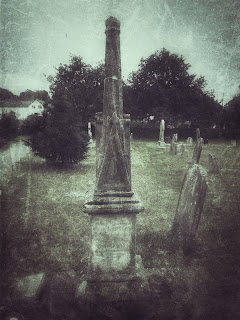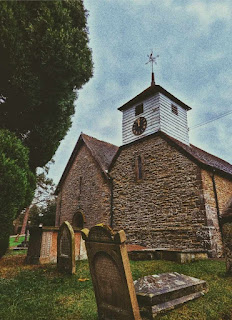The Sin Eater
The concept of Sin Eating was first introduced to me when I
was a teenager, on reading ‘Precious Bane’ by Mary Webb. This fantastic novel (by
a frankly underappreciated author) sees the protagonist’s brother take on
the mantle of Sin Eater at his father’s funeral. Rather than this being seen as
an honourable position, Gideon is cast out from the village and his normal life,
He becomes a marginalised figure- ‘accursed’ even suffering a loss of his
humanity. The ‘Sin Eater’ is more than a
literary device; indeed, this folk practice is found all over the world, I want
to return to Sin Eating to understand what drove the practice, and those that participated,
with a focus on Rural England and Wales, and specifically Shropshire.
The origins of Sin Eating are seemingly multiple and
obscured by the passage of time; however, the practice and imagery springs up
cross-culturally, and I thought it may be worth noting some of these examples. The Aztec Goddess of fertility, motherhood, and
the earth, Tlazolteotl is often depicted providing redemptive salvation to individuals
after death by ‘eating the filth of the soul.’ In many societies, there
is also a concept of a pre-ordained individual who is designated to suffer and atone
for the sins of others- such as the Sacral King. Indeed, even Jesus can be seen
as setting precedence for Sin-Eaters- by sacrificing his ‘pure soul’
for the sins of the world.
On the most basic level, The Sin Eater is an individual who
nominates themselves to take on the sins of another person, usually who has
died before death rites and absolution could be performed. The ritual itself is rather simple, involving
the nominated eating a ‘meal’ over the person's corpse. This ensured the spiritual
safety of the dead, and safe passage of the soul to heaven. Through the literal consumption of Bread,
wine or ‘burial cakes’ the eater would be also consuming the sins of the
person, freeing the deceased of their sins and earthly ties, and thus allowing
them to gain an appropriate Christian burial. Prayers would be said over the
corpse to cement the ritual. Prayers may take a format such as this-
‘I
give easement and rest now to thee,
Come
not down lanes or in our meddowes
And
for thy peace, I pawn my soul, Amen’
Sin Eating also
served a practical purpose, but ensuring the village was safe from the sin
ridden dead. The theory was that without
the appropriate death rites, the dead would be left to wander and cause harm to
the local area. Thus, Sin eating served as the next best thing- By removing the
sins from the physical body, there was nothing blocking a passage to heaven.
This meant the ties to the mortal world would be severed, leaving the village ‘spook’
free.
Though there is some speculation regarding when the practice
began, the first concrete mention of this practice takes place in the 1600s, by
Diarist John Aubrey who writes that at funerals-
‘hire poor people,
who were to take upon them all the sinnes of the party deceased…. when the
Corps was brought out of the house, and layd on the Biere; a Loafe of bread was
brought out, and delivered to the Sinne-eater over the Corps, and also a
Mazar-bowl of maple (Gossips bowle) full of beer, which he was to drinke up’
It is important to note here the emphasis on ‘poor people’
being the ideal candidate for Sin Eating. Indeed, the average sin-eater would
have come from the most marginalised areas of society- Think drunkards, beggars,
the poor and vulnerable. Unfortunately, at the time their souls were already
deemed to be corrupted, and therefore of less spiritual worth. Individuals of
such fortune were already cast out and ridiculed, enduring a multitude of hardships,
thus to superstitious villagers, it would not be hard to ostracise them further.
Professor Evans described a Welsh Sin
Eater’s life in 1825, suggesting that they lived in remote places, and were avoided
in the same way a leper would be. One cannot help but feel for such a lifestyle,
however, there may have been a pragmatic reason why people were drawn to such a
lifestyle. Indeed, in some areas of the country Sin-Eaters were paid up to 6
pence at a time and given flasks of beer as well as the food involved in the
ritual. For those experiencing hardship- pawning one’s soul must have seemed
attractive.
Though it was certainly an earlier practice, Charlotte Burne
suggests that the first connection to Sin Eating, and Shropshire lies in a 1714
letter by John Bagford. In this letter, he says that.
‘In Shropshire…when a person dyed there was notice given
to an old sire… who repaired to the place where the deceased lay… and the
family furnished him with a cricket (Seat)… then they gave him a groat which he
put in his pocket, a crust of bread which he ate, and a full bowle of ale,
which he drank off at a draught… then pronounced with a gesture- The ease and
rest of the soul departed, for which he would pawn his own soul’
This demonstrates that Sin Eating, in one form or another
was present in the 18th century. Further references of Sin Eating in
Shropshire from the 19th or even early 20th century are
seen to be symbolic survivals of the practice, such as a burial in 1893 in
Market Drayton which featured a Sin Eater or having been resurrected from antiquity
for the occasion.
I think it is important to note here the isolating power that
such a role would have on an already vulnerable person. Though I am looking through
a modern perspective, this does not discredit that in rural societies, family
and community ties were paramount. Amidst the mire of quasi-religion and
folklore, Sin-Eaters, though benefiting from the food and pay, were shunned as
omens of misfortune. It was considered extremely unlucky to look directly into
the eyes of a sin eater, lest the sin be transferred, and they were deemed as akin
to witches, or harbingers of death within the communities they had once called
home. The psychological effects of this must have become overwhelming. One must
remember that these individuals were exactly that- human beings who desired
interaction and human warmth. Such basics they were often lacking in. Think
back to Gideon, who becomes the ‘accursed Sin Eater,’ who is shunned
even by his own mother, the woman who brought him into the world. Although
fictionalised I think it demonstrates the stigma these individuals faced. Due to
already having pre-existing issues, such as poverty or alcoholism, being a Sin
Eater just added a further layer of stigma. Imagine for a moment the effect
this must have had on the psyche, knowing, and believing that their soul was
marred beyond repair, the isolation of daily life. One can only
assume the anger and doubt that must have been in the mind of the Sin Eater
who believed in the practice. Regardless of if the Eater believed in the
folklore behind the practice or not, to be a professional Sin-Eater must have
been one of the loneliest jobs in the world.
Furthermore, another stigma faced was from the clergy,
particularly the Catholic church. The church held the monopoly on absolution,
and thus any non-ecclesiastical attempt to absolve the deceased sin was
heretical and punishable by death. However, it was uncommon within rural
England to see this being enforced, it shows that, to respectable society the
Eater was ‘sin riddled, heretical and unlucky’.
I want to turn now back to Shropshire,
to discuss Richard Munslow, who is often credited as being Shropshire’s last Sin
Eater. Richard was born in 1833 and hailed from the village of Rattlinghope,
near Shrewsbury. He died in 1906. His entrance into the world of Sin Eating is atypical
of what we have been discussing. He was not a vulnerable man, rather a local farmer
of some prominence.
The stories are conflicted as to
why such a fellow would choose to be a sin-eater, he certainly did not need the
money or food. Local stories suggested that he did it out of kindness for his
fellow man, or perhaps for religious reasons. What is known is that Richard
advocated and resurrected this practice after it had begun to decline in the
late 19th century.
If we did a bit deeper, however, we
may find a plausible answer as to why Richard became a sin eater. Richard Munslow’s
personal life was fraught with grief. Indeed, he lost four of his children when
they were a very young age. Three of his children all died in the same horrible
week in May 1870. The scope of this loss
is unthinkable, and I feel there are no words to describe such a cataclysmic
loss. It has been speculated that Richard’s call to Sin Eating came from a place
of grief, and a means to heal. Whatever the reason, one can only feel for
Richard Munslow, but it is comforting to know that he was very popular in the
local area, and kept the practice alive until his death.
Richard is buried in St Margaret churchyard, reunited with
his children. His name has an established place in the folklore of
Shropshire, and in 2010 his grave was restored by the local community. I am
glad they did, he deserves to be remembered. His grave serves as a
reminder of the importance of folk customs, as well as the impact they had on
rural lives. If you ever find yourself in his quiet corner of Shropshire, pop and
see him, look around the churchyard and see all the names of those he ‘gave an easement to’ and think a while about the lengths we as humans will go to, to
procure a good death and safe afterlife.


.jpg)
Thanks for sharing this interesting article
ReplyDeleteReally interesting. Thanks
ReplyDelete